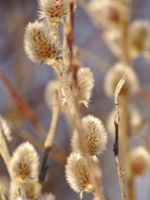Mon-Fri 9am - 5pm Mountain time
Common Hackberry vs Pussy Willow
Salix discolor
Celtis occidentalis
Pussy Willow is a large shrub or small tree that produces catkins that are soft, silky, and silvery before leaves appear in the spring. This native willow prefers moist to wet soil.
Pussy Willow makes a beautiful accent tree, and its bright branches can be used for floral arrangements or basket making.
All willow are important to native pollinators each spring as they have higher amounts of pollen and nectar early each growing season when other food sources are scarce.
The Common Hackberry is a medium-sized deciduous tree that resembles the American Elm but is immune to Dutch Elm Disease. They are versatile and can adapt to a variety of growing conditions.
It produces purple-red, berry-like fruit with a large seed in the center. Both the sweet flesh, which tastes similar to dates, and the crunchy seed are edible. The fruit remains on the tree throughout the winter, offering a valuable food source for birds and other wildlife.
The Common Hackberry can also be a great addition to a pollinator garden. The tree itself is a host for the larvae of several butterfly species and the flowers provide a source of pollen and nectar.

